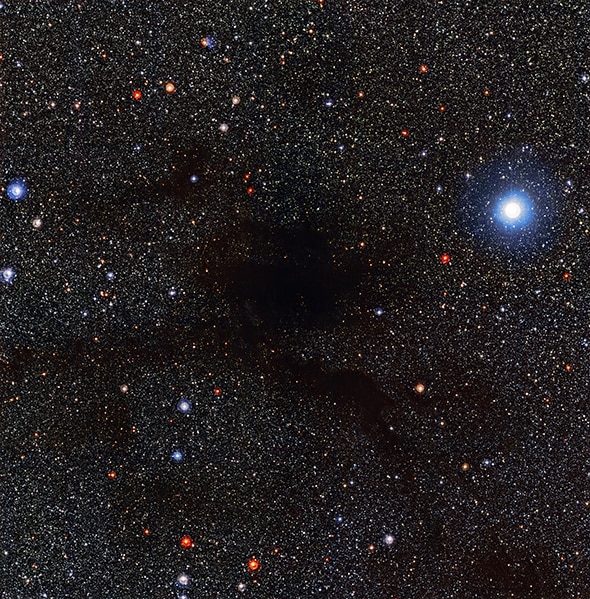Create a free profile to get unlimited access to exclusive videos, sweepstakes, and more!
The Dark Cloud of the Wolf

The space between stars is not empty.
Dark, cold, ghostlike material lurks there, as thin as a politician’s promise. Astronomers call this material “dust,” but don’t be fooled; it’s not like the little tumbleweeds you find under your desk. This stuff is made of grains of minerals and complex carbon-based molecules much like soot, created in the atmospheres of stars and blown out into the depths of space.
In the denser clouds of dust there might be a million particles in a single cubic centimeter of space. That may sound like a lot, but it’s one-ten-trillionth the density of the air you breathe.
Still, over hundreds of trillions of kilometers, even material this ethereally dispersed adds up. These grains and molecules of dust are very good at absorbing visible light, blocking it from passing through the clouds. As it happens, many of these clouds are located in the plane of our galaxy, the parts of our sky where stars are crowded together. When a cloud is between us and those stars, it looks like a hole in space, a place where the galaxy forgot to make stars.
The picture at the top of this article is one such cloud: Lupus 4, a vast filamentary structure 400 light-years away and about 10 light-years across. It was taken with the Wide Field Imager on the MPG/ESO 2.2-meter telescope at the La Silla Observatory in Chile, and the field of view is about a degree across: twice the width of the full Moon on the sky. That’s staggeringly big. Some people say it looks like a spider, but to me it more resembles some sort of cephalopod, its tentacles reaching out to us …
And that description is more apt than you might think.
Lupus is the constellation of the wolf, located not far from the center of the galaxy in the sky, where dust, gas, and stars are thickest. Lupus 4 is part of the sprawling Scorpius-Centaurus OB association, a loose cluster of massive stars that’s one of the very closest to Earth. These stars are young, and don’t live long; after a few million years they explode, scattering heavy elements into space.
A little while back, scientists studying ocean floor sediments examined a core taken out of the Atlantic Ocean seabed. They found a spike in an isotope of iron, called iron-60, dating to about 3 million years ago. Iron-60 is radioactive with a short half-life, and as far as we know only produced naturally in one place: a supernova. An exploding star.
That means either the material blasted away from a supernova swept over the Earth and deposited that material, or our solar system passed through a region of space where the blast wave from a supernova had stagnated (stopped after plowing through the material between the stars). Since iron-60 decays rapidly, either way it means this must have been from a cosmically young supernova.
As it happens, the stars in the Scorpius-Centaurus OB association are at the right distance to be implicated in this. Millions of years ago, one of them reached the end of its life, blew up, and sent material fleeing outwards at a substantial fraction of the speed of light. Some of that material managed to reach Earth, fall to the bottom of the ocean, and await our notice.
I mentioned that clouds like Lupus 4 appear to be where the galaxy forgot to make stars. But ironically, these clouds are generally the sites of star formation; it’s just hidden from us by the thick soup of dust. It’s possible that the star that blew up all those ages ago formed in a cloud just like Lupus 4 (perhaps in one of its neighboring clouds), and in death managed to physically touch our planet across four thousand trillion kilometers of space.
Like I said. Its tentacles, reaching out to us …


























